
Isostatic Press
Automatic Lab Cold Isostatic Press CIP Machine Cold Isostatic Pressing
Item Number : PCIA
Price varies based on specs and customizations
- Working pressure
- 0-100 T
- Piston diameter
- φ110-φ200 mm
- Cylinder stroke
- 50 mm
- Isostatic pressure
- 0-500 MPa
Shipping:
Contact us to get shipping details Enjoy On-time Dispatch Guarantee.
Why Choose Us
Reliable PartnerEasy ordering process, quality products, and dedicated support for your business success.
Applications
Automatic Cold Isostatic Press (CIP) is widely used in materials research laboratories, pharmacy, catalytic reaction, ceramics, electronic industries, it is a high-efficiency equipment for sample preparation, due to its small size, it is easy to transport and move, it can work inside the vacuum glove box for processing under vacuum environment.
By applying the same pressure to each surface of the sample, automatic cold isostatic press increases the density of the sample by applying a high pressure environment, and obtains a sample of the shape desired.
The automatic cold isostatic press has more advanced features and capabilities than the electric cold isostatic press. It can be programmed to meet the specific requirements of a given test, providing greater flexibility and control.
Features
- Small size, light weight, easy to transport and move, well-fitting vacuum glove box
- High-precision digital pressure gauge
- The pressure can be programmed, the hydraulic system will return It will start working when the pressure drops to the set value.
- The isostatic press creates higher, more uniform pressure around the samples, increasing sample density.
- The split structure can provide even more than 100 tons of pressure.
- The program automatically converts the pressure on the sample.
- Intelligent and automatic, pressurization/slow pressurization program - automatic pressure maintenance - automatic pressure compensation - pressure relief time.
- The rocker structure on the top plate makes the operation more convenient
- Can be customized to your needs
Details and pieces
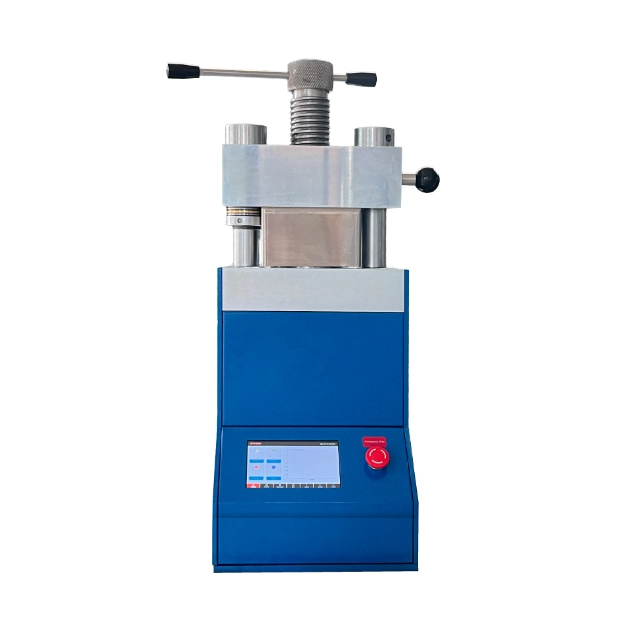
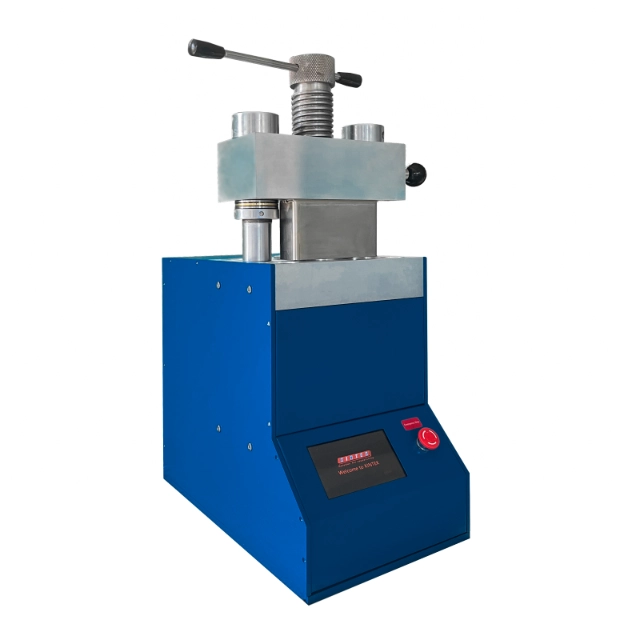
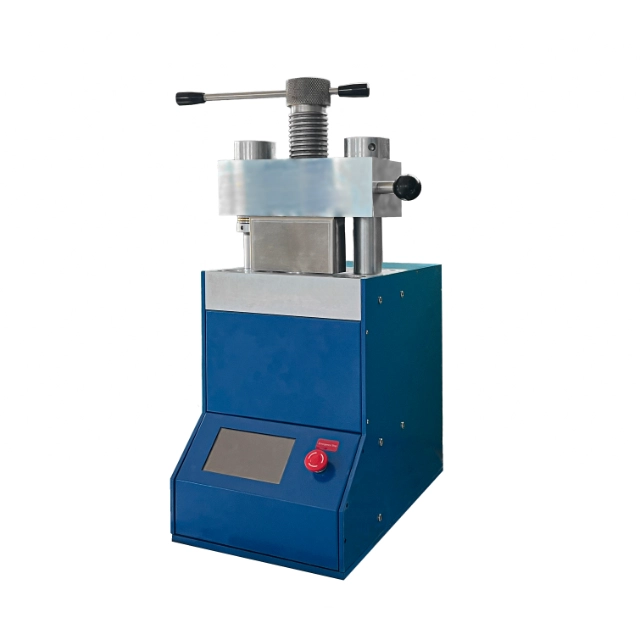
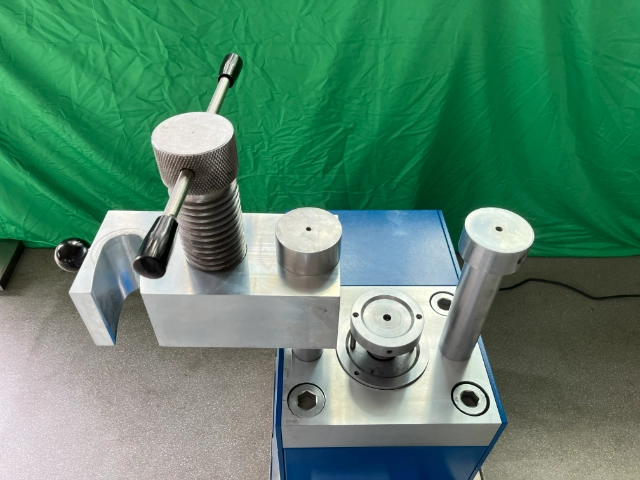
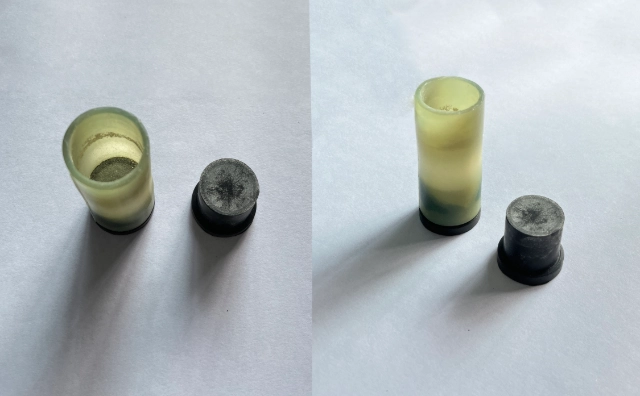
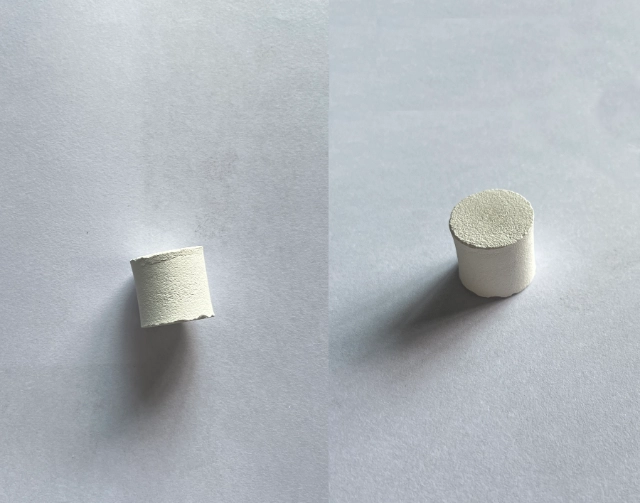
- Automatic: Totally automatic sub-tablet tablet press, programmable pressurization, easy operation and other fans, suitable for high-end laboratories.
- Efficacy: Simplify the charging/expulsion process. Shorten the operating time and improve the effectiveness of the work.
- Display: LCD panel, the operation is most intuitive and the display is clear. Convenient for users to operate.
Operation interface
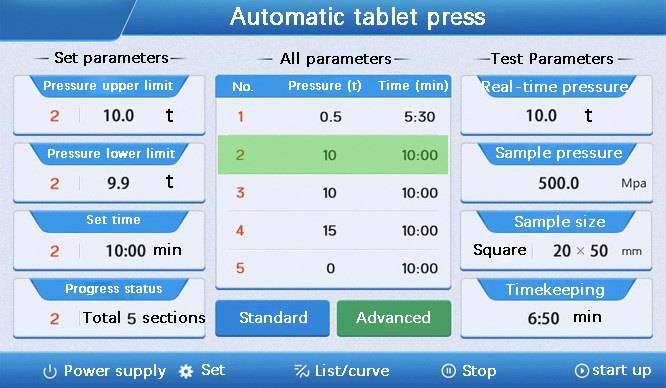
- Start button: Pressurize according to multiple pressurization programs.
- Stop button: During pressurization, you can stop the pressurization process.
- Set button: Click the button configuration to enter the menu configuration.
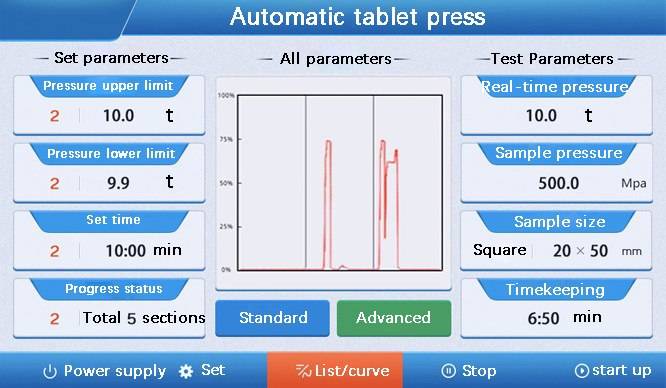
- List/Curve: You can switch between displaying lists and curves.
Advantages
- The top plate adopts electroplated countersunk head hex screws, which are beautiful and save space.
- Chrome-plated cylinder, surface Smooth, rust-free, good sealing rubber ring, no oil leaks.
- One-piece main board structure, oil pool, main board, and oil cylinder in one body, no seal connection.
- Extended traction spring, good rebound effect, not easy to deform, can achieve 30mm cylinder return without deformation.
- All-aluminum alloy flywheel, beautiful, practical, not easy to break.
- Small size, light weight, no oil leaks, can be used in the glove box.
- Japanese high-speed steel mold, good material, high hardness, no deformation, long life. Useful
- Digital display pressure gauge, more precise pressure control, with a pressure display accuracy of 0.01 MPa
- Oil pool outside the host, easy to replace the oil, and the oil circuit has an increased hydraulic oil filtration device
- Special plunger, using a special custom-made sealing structure, excellent sealing effect
- Pressurization device, placed at the lower corner of the main frame, with a reasonable angle, and the pressurization force does not tilt backward
Technical Specifications
| Apparatus Model | PCIA-20T | PCIA-40T | PCIA-60T | PCIA-100T |
|---|---|---|---|---|
| Piston Diameter | 110 mm (d) in chrome-plated oil cylinder | 130 mm (d) in chrome-plated oil cylinder | 150 mm (d) in chrome-plated oil cylinder | 200 mm (d) in chrome-plated oil cylinder |
| Machining Process Pressurization | Program Pressurization - Program Maintenance - Timed Pressure Release | Program Pressurization - Program Maintenance - Timed Release | Program Pressurization - Program Maintenance - Timed Release | Program Pressurization - Program Maintenance - Timed Pressure Release |
| Pressure Conversion | The program automatically converts the sample withstand pressure | The program automatically converts the sample withstand pressure | The program automatically converts the Sample Withstand Pressure | The program automatically converts the sample withstand pressure. |
| Display | 4.3-inch LCD display | 4.3-inch LCD display | 4.3-inch LCD display | 7-inch LCD display |
| Equipment Protection | Steel plate protection with organic glass door | Steel plate protection with organic glass door | Steel plate protection with glass door organic | Sheet steel protection with organic glass door |
| Isostatic pressure | 300-500MPA | 300-500MPA | 300-500MPA | 300-500MPA |
| Pressure chamber lsostatics | Φ30×150mm(M×N) | Φ40×150mm(M×N) | Φ50×150mm/30×150mm | Φ60×150(M×N) |
| Cylinder stroke (T) | 50mm | 50mm | 50mm | 50mm |
| Characteristics of the manufacture of Samples | Top panel rocker structure for more comfortable operation | Top panel rocker structure for more comfortable operation | Top panel rocker structure for more comfortable operation | Top panel rocker structure for more comfortable operation |
| Dimensions exterior | 240×390×560(LENGTH×WIDTH×HEIGHT) | 280×460×660(L×W×H) | / | 330×580×720(L×W×H) |
| Equipment power supply | 550W(220V/110 can be customized) | 550W(220V/110 can be customized) | 550W(220V/110 can be customize) | 550W(220V/110 can be customized) |
| Weight of the equipment | 120KG | 180KG | 240KG | 290KG |
Full range of lab press types
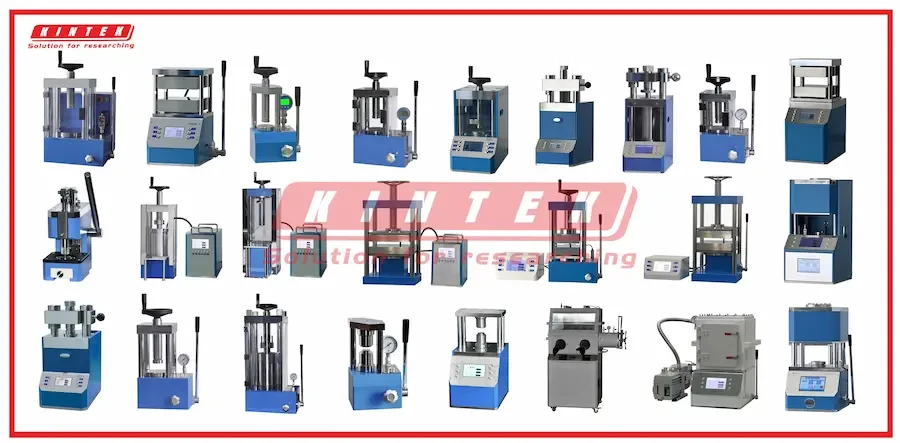
Click to view our full range of lab press products.
Any question? Our experts have helped many laboratories choose their lab press, contact us now!
Full range of types of laboratory press molds
We have a full range of molds for you to choose from, and the molds fit the body perfectly.
If you need molds with special shapes, we can also customize them for you.
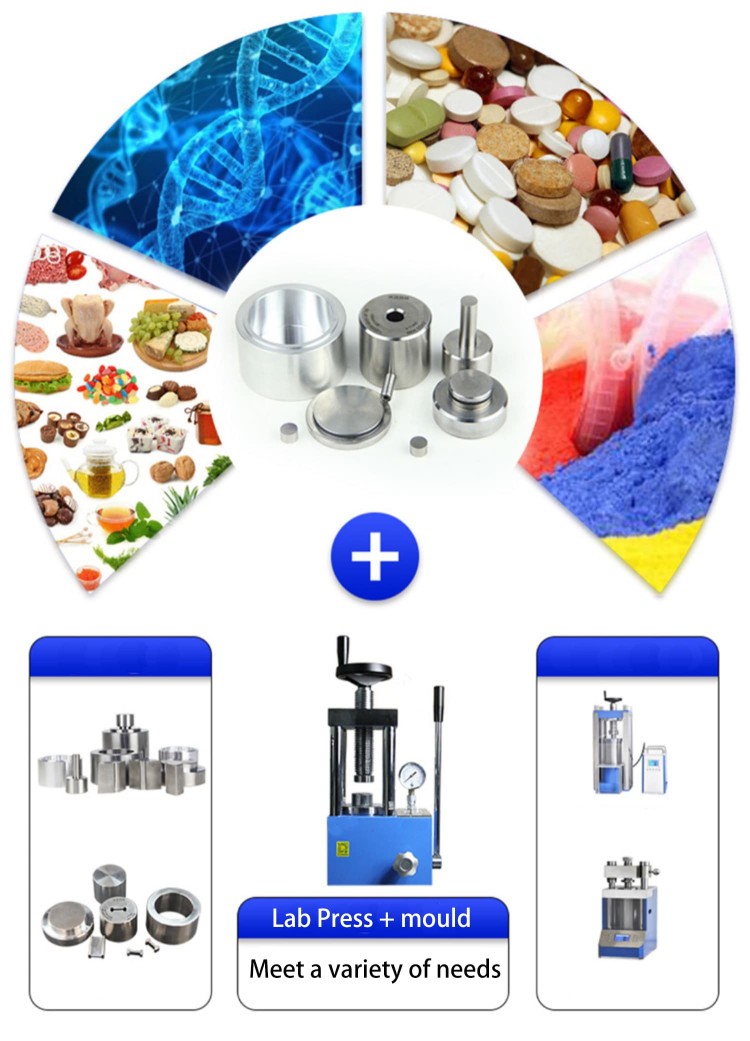
Warnings
Operator safety is the top important issue! Please operate the equipment with cautions. Working with inflammable& explosive or toxic gases is very dangerous, operators must take all necessary precautions before starting the equipment. Working with positive pressure inside the reactors or chambers is dangerous, operator must fellow the safety procedures strictly. Extra caution must also be taken when operating with air-reactive materials, especially under vacuum. A leak can draw air into the apparatus and cause a violent reaction to occur.
Designed for You
KinTek provide deep custom made service and equipment to worldwide customers, our specialized teamwork and rich experienced engineers are capable to undertake the custom tailoring hardware and software equipment requirements, and help our customer to build up the exclusive and personalized equipment and solution!
Would you please drop your ideas to us, our engineers are ready for you now!
FAQ
What Is A Lab Press?
What Is Isostatic Pressing?
What Are The Benefits Of Isostatic Pressing?
What Is Cold Isostatic Pressing (CIP)?
Cold Isostatic Pressing (CIP) is a process used to compact and mold powders and other materials into a desired shape by applying hydrostatic pressure at room temperature. The process is performed using a flexible mold, typically made of rubber or plastic, that is filled with a liquid pressure medium such as water, oil, or a specialized fluid.
What Is The Purpose Of A Hydraulic Press In Lab?
What Are The Types Of Isostatic Pressing?
There are two main types of isostatic pressing:
- Hot Isostatic Pressing (HIP): This type of isostatic pressing uses high temperature and high pressure to consolidate and strengthen the material. The material is heated in a sealed container and then subjected to equal pressure from all directions.
- Cold Isostatic Pressing (CIP): In this type of isostatic pressing, the material is compacted at room temperature using hydraulic pressure. This method is commonly used to form ceramic and metal powders into complex shapes and structures.
What Are Different Type Of Lab Presses?
What Type Of Isostatic Pressing Equipment Do You Have?
What Are The Advantages Of Cold Isostatic Pressing?
- High green strength: Machining of the compacted material in its green state becomes more feasible.
- Materials that are hard to press: Isostatic pressing can be performed on powders without the need for water, lubricants, or binders, making it applicable to a wider range of materials.
- Predictable shrinkage during sintering is achieved due to the high compaction and uniform density.
- Time and cost savings in post-processing are possible due to the ability to create large, complex, and near-net shapes.
- Large aspect ratio parts with uniform density can be produced, resulting in improved quality.
- Green strength enables efficient in-process handling and treatment, reducing production costs.
What Is A Cold Isostatic Press?
A cold isostatic press (CIP) is a machine used to compact and mold powders and other materials into a desired shape.
The process works by filling a flexible mold, usually made of rubber or plastic, with a liquid pressure medium like water, oil, or a specialized fluid. This mold is then placed in a closed container, and equal pressure is applied to each surface to achieve a high-pressure environment.
The pressure results in an increase in the product's density and allows it to take on the desired shape.
Cold isostatic pressing is performed at room temperature, in contrast to hot isostatic pressing which is carried out at higher temperatures.
What Are The Wet Bag Process And The Dry Bag Process?
The CIP molding process is divided into two methods: the wet bag process and the dry bag process.
Wet bag process:
In this method, the powder material is placed in a flexible mold bag and placed in a pressure vessel filled with high-pressure liquid. This process is ideal for producing multi-shaped products and is suitable for small to large quantities, including large-sized parts.
Dry bag process:
In the dry bag process, a flexible membrane is integrated into the pressure vessel and is used throughout the pressing process. This membrane separates the pressure fluid from the mold, creating a "dry bag." This method is more hygienic as the flexible mold does not get contaminated with wet powder and requires less cleaning of the vessel. It also features fast cycles, making it ideal for mass producing powder products in an automated process.
Application Field Of Cold Isostatic Press?
Cold Isostatic Pressing is widely used for various applications, including the consolidation of ceramic powders, compression of graphite, refractory materials, and electrical insulators, as well as the production of fine ceramics for dental and medical applications.
This technology is also making inroads into new fields such as pressing sputtering targets, coating valve parts in engines to reduce wear on cylinder heads, telecommunications, electronics, aerospace, and automotive industries.
What Are The Wearing Parts Of Cold Isostatic Pressing Equipment?
The wearing parts of cold isostatic equipment are mainly various seals, such as various types of seal rings, valve cores and valve seats.
Do You Provide Matching Cold Isostatic Press Molds?
We offer a variety of standard mold shapes for customers to experiment or validate their process. Custom mold design services are also available upon request.
How Long Is Your Delivery Time? If I Want To Customize The Instrument, How Long Does It Take?
4.8
out of
5
This automatic cold isostatic press is a real workhorse! It's incredibly efficient and easy to use, helping us significantly improve our productivity.
4.9
out of
5
The press's compact size and portability make it perfect for our limited lab space. It's a great investment that has enhanced our research capabilities.
4.7
out of
5
The pressure gauge's precision and accuracy are top-notch, enabling us to achieve consistent and reliable results. This press has become an indispensable tool in our lab.
4.8
out of
5
The customizable features, including programmable pressurization and automatic pressure maintenance, have made our sample preparation process much more efficient and streamlined.
4.9
out of
5
The split structure allows for exceptional pressurization, ensuring uniform pressure distribution and optimal sample density. This press has exceeded our expectations.
4.7
out of
5
The intelligent and automatic features, such as automatic pressure compensation and timing pressure relief, have simplified our workflow and saved us valuable time.
4.8
out of
5
The LCD screen display enhances user-friendliness, providing clear and intuitive instructions. Operating this press has been a breeze for our lab technicians.
4.9
out of
5
The sample preparation and mold release processes are remarkably efficient, minimizing downtime and maximizing our productivity. This press has been a game-changer for our lab.
4.7
out of
5
The press's durability is exceptional. Despite rigorous use, it continues to perform flawlessly, delivering consistent results. We highly recommend this product.
4.8
out of
5
The technological advancements incorporated into this press are truly impressive. It has revolutionized our sample preparation, enabling us to achieve higher precision and accuracy in our research.
4.9
out of
5
The versatility of this press is remarkable. Its wide range of applications, from material research to pharmaceutical studies, makes it an invaluable asset to our lab.
4.7
out of
5
The value for money is simply unbeatable. This press offers exceptional performance and features at a competitive price point. We couldn't be happier with our purchase.
4.8
out of
5
The fast delivery and seamless installation process were the icing on the cake. We were up and running with this press in no time, minimizing disruption to our research.
REQUEST A QUOTE
Our professional team will reply to you within one business day. Please feel free to contact us!
Related Products

Electric Lab Cold Isostatic Press CIP Machine for Cold Isostatic Pressing
Produce dense, uniform parts with improved mechanical properties with our Electric Lab Cold Isostatic Press. Widely used in material research, pharmacy, and electronic industries. Efficient, compact, and vacuum-compatible.

Cold Isostatic Pressing Machine CIP for Small Workpiece Production 400Mpa
Produce uniformly high-density materials with our Cold Isostatic Press. Ideal for compacting small workpieces in production settings. Widely used in powder metallurgy, ceramics, and biopharmaceutical fields for high-pressure sterilization and protein activation.

Electric Split Lab Cold Isostatic Press CIP Machine for Cold Isostatic Pressing
Split cold isostatic presses are capable of providing higher pressures, making them suitable for testing applications that require high pressure levels.

Manual Cold Isostatic Pressing Machine CIP Pellet Press
Lab Manual Isostatic Press is a high-efficient equipment for sample preparation widely used in material research, pharmacy, ceramics, and electronic industries. It allows for precision control of the pressing process and can work in a vacuum environment.

Isostatic Molding Pressing Molds for Lab
Explore high-performance isostatic pressing molds for advanced material processing. Ideal for achieving uniform density and strength in manufacturing.

Introducing the KINTEK KBR Press - a handheld laboratory hydraulic press designed for entry-level users.

Vacuum Cold Trap Chiller Indirect Cold Trap Chiller
Boost vacuum system efficiency and prolong pump life with our Indirect Cold Trap. Built-in chilling system with no need for fluid or dry ice. Compact design and easy to use.

Efficient split chamber CVD furnace with vacuum station for intuitive sample checking and quick cooling. Up to 1200℃ max temperature with accurate MFC mass flowmeter control.

Multi Heating Zones CVD Tube Furnace Machine Chemical Vapor Deposition Chamber System Equipment
KT-CTF14 Multi Heating Zones CVD Furnace - Precise Temperature Control and Gas Flow for Advanced Applications. Max temp up to 1200℃, 4 channels MFC mass flow meter, and 7" TFT touch screen controller.

No Demolding Lab Infrared Press Mold for Laboratory Applications
Effortlessly test your samples with no demolding required using our lab infrared press mold. Enjoy high transmittance and customizable sizes for your convenience.

Warm Isostatic Press WIP Workstation 300Mpa for High Pressure Applications
Discover Warm Isostatic Pressing (WIP) - A cutting-edge technology that enables uniform pressure to shape and press powdered products at a precise temperature. Ideal for complex parts and components in manufacturing.

Warm Isostatic Press for Solid State Battery Research
Discover the advanced Warm Isostatic Press (WIP) for semiconductor lamination. Ideal for MLCC, hybrid chips, and medical electronics. Enhance strength and stability with precision.
Related Articles

Electric Lab Cold Isostatic Press (CIP): Applications, Benefits, and Customization
Explore the versatile world of Electric Lab Cold Isostatic Press (CIP) technology. Learn about its applications in various industries, benefits, and customization options for tailored solutions.

Exploring the Applications of Isostatic Pressing
Isostatic pressing is a powder metallurgy technique that applies equal pressure from all directions to a compacted powder. There are two types of isostatic pressing: cold isostatic pressing (CIP) and hot isostatic pressing (HIP). CIP uses pressure at room temperature, while HIP applies heat and pressure to the powder.

Application of Hot Isostatic Pressing Technology in Nickel-Based Casting High-Temperature Alloys
Explores the use of hot isostatic pressing to enhance the properties of nickel-based casting high-temperature alloys in aerospace applications.

Application of Hot Isostatic Pressing Technology in Special Ceramic Preparation
Explores the use of HIP technology in special ceramics, focusing on preparation, characteristics, and industry trends.

Principle and Process of Cold Isostatic Pressing
Explains the mechanism, factors, and process of cold isostatic pressing in powder molding.

Comprehensive Application of Cold Isostatic Pressing Technology
An overview of the wide-ranging applications of cold isostatic pressing technology across various industries.

Additive Manufacturing for Isostatic Pressing: Bridging New Technology with Traditional Manufacturing
The goal of most powder-based manufacturing processes, such as powder metallurgy (PM), is to produce dense parts with less than 1% porosity without melting the starting material. The loose powder used in these processes typically has a low stacking density, with a theoretical maximum density of only 64% for randomly stacked perfectly spherical particles. However, by using proper powder particle size distributions or deformable powders, packing densities of over 90% can be achieved.

The Tyranny of the Die Wall: How Isostatic Pressing Liberates Material Design
Cold Isostatic Pressing (CIP) overcomes die-wall friction to produce parts with superior density uniformity, enabling complex designs and performance.

The Hidden Flaw in Every Pressed Part, and How to Eliminate It
Discover how cold isostatic pressing (CIP) eliminates hidden density gradients common in manufacturing, ensuring superior material integrity.

Beyond the Piston: How Isostatic Pressing Solves the Hidden Flaws in Material Science
Cold Isostatic Pressing (CIP) overcomes the hidden density flaws of traditional methods by applying uniform pressure, creating superior material integrity.

Beyond Brute Force: The Physics of Perfect Density in Cold Isostatic Pressing
Discover how Cold Isostatic Pressing leverages Pascal's Law to achieve uniform density in ceramics and metals, preventing defects in high-stress components.

Cold Isostatic Pressing (CIP): A Proven Process for High-Performance Parts Manufacturing
Cold isostatic pressing (CIP) is a proven process that stands out when it comes to high-performance part manufacturing. The technology offers a range of advantages, from achieving superior densities in ceramics to compressing materials as diverse as metals and graphite.